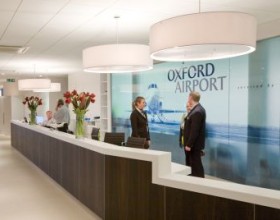
The case of the airport identity crisis isn’t exactly new. When you land in Barcelona Girona Airport about 55 miles stand between you and a visit to Spain’s second largest city.
Coasting down the runways at Memmingen (Munich West), you’ll have a bit of a wait before you can actually wander through the Bavarian capital – the airport is 70 miles outside of Munich.
Or touching down in Glasgow Prestwick and thinking you’re touching down in, well, Glasgow? Think again. You have a 30 mile journey ahead of you.
Now Oxford Airport, in Kidlington, Oxfordshire, is joining in re-branding itself as a London airport. Its newly updated website boasts that the airport is “40 miles northwest of the Greater London area”. It is 62 miles from central London.
So why would an airport like Oxford want to align itself with a city like London? As the travel industry struggles in a weak economy, this may just be one more way to try to stay afloat, says travel expert Simon Calder.
“Far more people fly in and out of the five recognised London airports than any other city’s airport systems, including New York and Tokyo,” he says. “It’s natural that airports would want to capitalise on that. Everyone, both airlines and airports, are desperate for business.”
A name change alone may not be enough to transform London Oxford into a London airport, though. The International Air Transport Association has not yet received an official request to add London to the name, according to a spokesperson from the organisation.
The IATA does not designate a radius for an airport to be listed under a given metropolitan area, but currently London’s officially recognised airports are London City, Heathrow, Gatwick, Luton and Stansted. London Ashford (73 miles from the city centre) and London Southend (43 miles from the city centre) also don’t make the list.
Yet with successful rebranding, these types of airports and the discount airlines who often use them have proven that secondary airports far outside the city can draw passengers with cheaper fares, says Mr Calder.
Other European cities, including Rome, Frankfurt, Oslo and Milan, are also served by airports that are miles away from the city centre.
But is the tactic a fair one? Maybe not, says John Tribe, tourism professor at the University of Surrey and editor of the Annals of Tourism Research, an academic tourism journal.
“It’s very misleading,” he says. “Oxford is Oxford. London is London. They are two different places.” And while people in the UK may be able to understand the difference, Mr Tribe says international visitors may be disappointed. “If I were going to London and I ended up in Oxford, I think I’d be crushed,” he says.
And it’s not necessarily just about distance, he says. After all, London’s five major airports are all between nine and 38 miles from the city centre.
Instead, it comes down to accessibility, according to Mr Tribe. Travelling from London Oxford Airport to London will typically require passengers to first take a bus to the Oxford city centre and then to transfer to a train or bus for London.
Currently, there is no legal standard for labelling airports with nearby – or not so nearby – cities, according to a spokesperson for ABTA – The Travel Association in the UK.
This means most of the responsibility comes down to the passengers to research the airport before booking. And a lack of preparation can lead to confusion.
In some cases, relabelled airports have landed passengers across not just city lines, but international borders. In 2002, uproar ignited among passengers after Ryanair advertised bargain flights to Copenhagen, Denmark. The planes were landing in Malmo, Sweden instead.